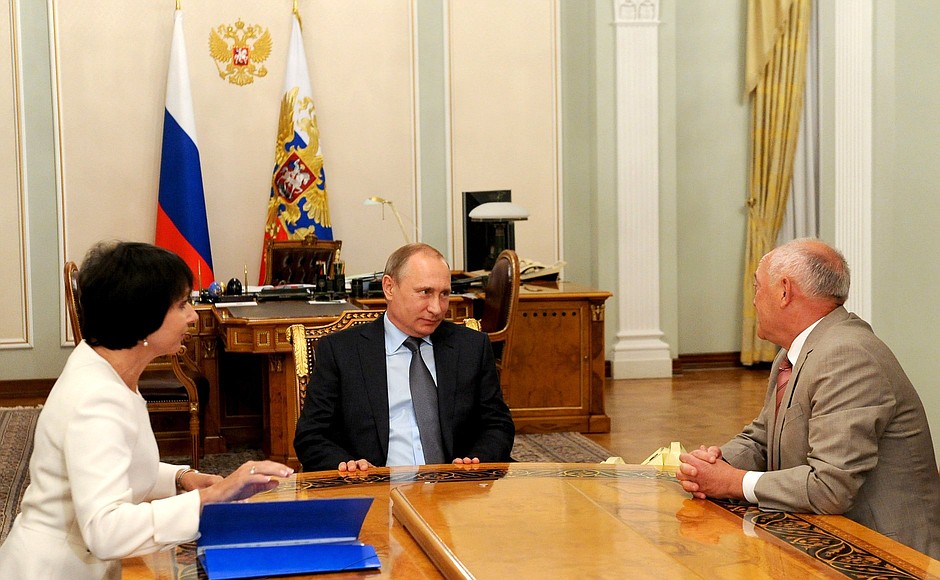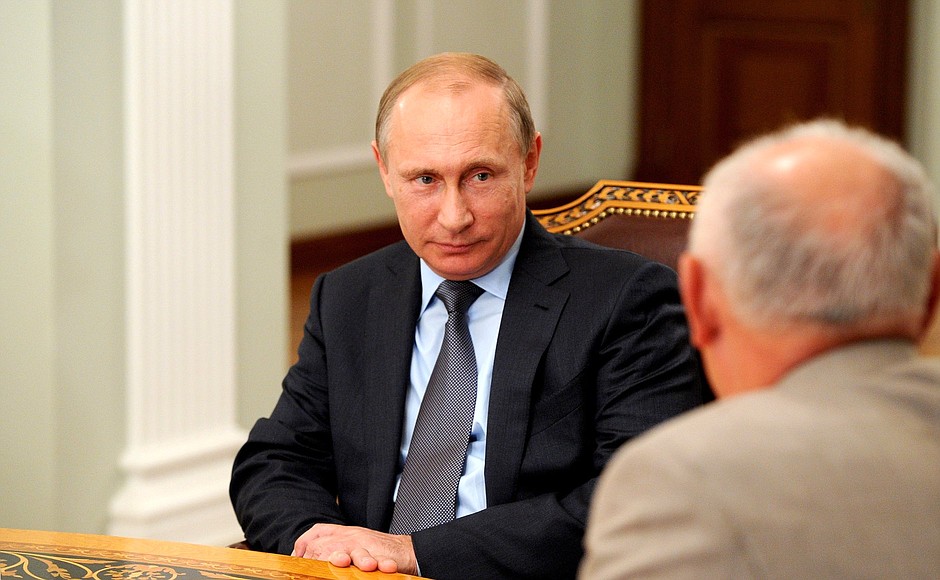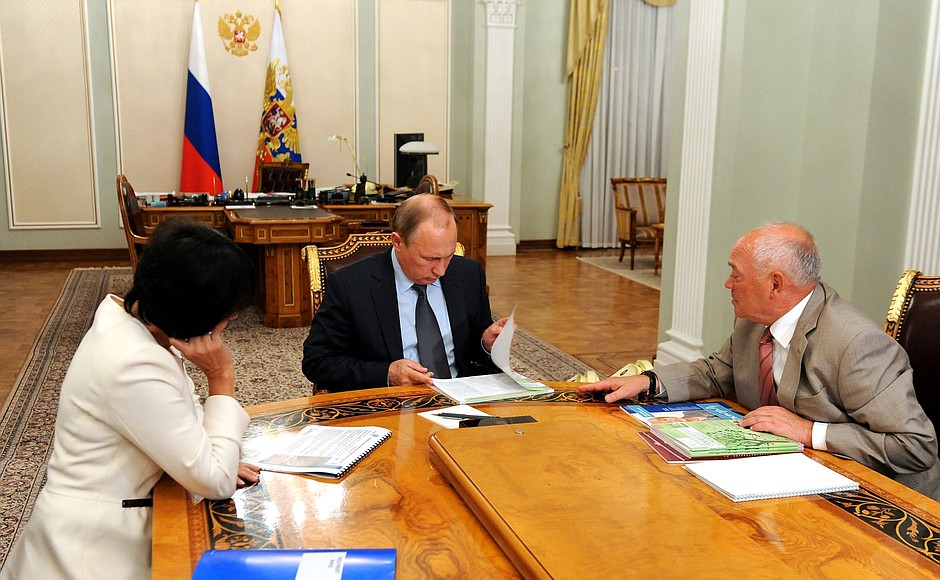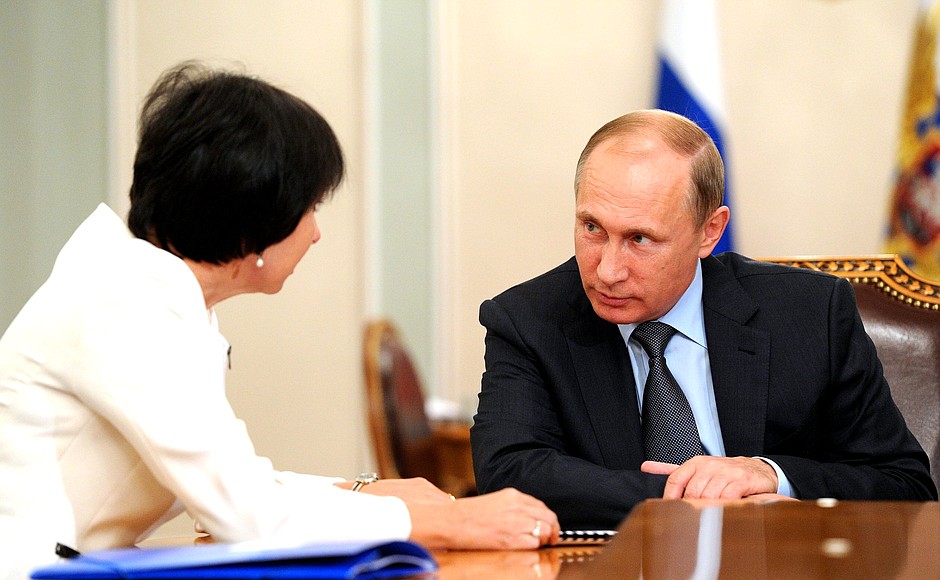The decision to establish a specialised children’s centre of this type was made after the President met with leukaemia patient Dima Rogachev in 2005, whose name was subsequently given to the Federal Research Centre of Paediatric Haematology, Oncology and Immunology. Mr Putin kept personal watch on the centre’s construction, and it has particular significance for the President.
The Dima Rogachev Federal Research Centre of Paediatric Haematology, Oncology and Immunology is a unique research and treatment facility that provides advanced technology treatments for children as inpatients and outpatients, and develops and introduces common internationally recognised treatment procedures for diseases of the blood, immune system, malignant tumours, and other serious diseases affecting children.
Beginning of meeting with the heads of children’s haematology, oncology and immunology centre
President of Russia Vladimir Putin: How is your work going? I know that you are expanding and moving into a new Moscow district too.
Director of the Dima Rogachev Federal Research Centre of Paediatric Haematology, Oncology and Immunology Alexander Rumyantsev: Yes.
Vladimir Putin: I’d like to hear about it.
Alexander Rumyantsev: Ten years have gone by now since your meeting with Dima Rogachev. That was an important moment not just for the doctors, but also for the children and their parents. It was this meeting that paved the way for what became a unique and innovative project – to build a children’s treatment centre using the latest technology and bring together under one roof the fast-developing immunology fields in medicine.
The clinic is working very intensively now. We have 470 beds and we see around 50,000 patients a year. We perform around 1,200 operations of different types, using advanced technology, treating patients with an unfavourable prognosis. We perform up to 200 bone marrow transplants every year.
Two years ago, following your instruction, we took possession of a centre outside the city for carrying out our rehabilitation programmes.
Vladimir Putin: This was all rather a slow process.
Alexander Rumyantsev: Yes, it took two years. But Mr President, first, there were the legal matters to settle. I can inform you now that the 125 hectares of land have been fully integrated into one single institution. We have merged them into one facility. Today, 1,500 patients and their family members are undergoing rehabilitation there. These are children recovering from cancer. This project is the only one of its kind in Russia. We now have 1,600 people working at the clinic.
Vladimir Putin: That’s a big team.
Alexander Rumyantsev: It’s a huge team. The centre has become one of the leaders in its field in Russia. We are the only children’s centre among the top three institutions in the country in both research and practice. We provide simultaneous treatment to around 500–550 children with illnesses in the fields in which we work. These are children with very serious illnesses from every region of the country.
Ms Novichkova will give you the details, but overall, what began as an idea ten years ago began operation four years ago, and since then we have been working very intensively to fulfil the missions we were given.
Vladimir Putin: How is your international cooperation developing?
Alexander Rumyantsev: We have invited five Western specialists to work with us. The first is a prominent specialist in morphology, working in Kiel, Germany. It is not boasting on my part to say that we now have the best morphology service in Russia, from the medicines the laboratories receive, to the ‘cloud’, where it is possible to get consultation on all these medicines at international level. This makes it possible to correct the original diagnoses for 40 percent of the patients. This centre has become a reference for the entire country.
Our second specialist is someone you have met with and known for many years now, Professor Gunter Hentze. He will turn 70 this year. We will congratulate him in November. He continues working with us and we are carrying out a big cooperation project on acute lymphoblastic leukaemia in Russia. Seventy Russian regions, as well as Belarus, Armenia and Uzbekistan, are taking part in a joint study that will take place over 20 years. We now have a cure rate of nearly 90 percent for acute lymphoblastic leukaemia in children. This is a unique result and concerns not just our clinic but the entire country.
Vladimir Putin: A 90 percent cure rate for leukaemia?
Alexander Rumyantsev: For leukaemia in children.
Vladimir Putin: What was the rate 10 years ago?
Alexander Rumyantsev: I cannot say exactly what it was 10 years ago, but we began with a rate of 7 percent.
Deputy Director and Chief Medical Officer Galina Novichkova: Can I tell you about our transplantation work? When we met several years ago, I showed you a graph depicting how many bone marrow transplants per 10 million people are performed in the world. The transplantation field has grown fast over the 3.5 years since then, and we still have a lot of work to do, of course, but the situation here is now much better than it was before.
Vladimir Putin: There has been a more than 10-fold increase.
Galina Novichkova: That’s right. The children were getting chemotherapy as it was back then, and those who had enough chemotherapy had good treatment results, but those who needed transplants had no chance of getting them. Now, nearly 40 percent of the children receive transplants. There is still work to do, but this is big progress already.
Vladimir Putin: This is excellent.
What about the research centre you established, is it up and running?
Alexander Rumyantsev: Very much so. The molecular biology, immunology and other laboratories are all in operation and ensure a high rating for our research facilities.
Vladimir Putin: So as well as the clinic, you also have the research centre.
Alexander Rumyantsev: That’s right, and it continues to grow.
I brought along a few materials to show you. We have linked all doctors in Russia working in our field into a single network. Here is a collection of information on every centre around the country working with us. We publish this collection every year, so people can read about each centre and see who is doing what. We have had this association up and running for five years now and working in full. Our centre is the main link in this work.
This association covers all regions of the country and brings together around 600 doctors. The most important thing though, is that we have standardised treatment and diagnosis programmes for all groups of patients. Patients in Vladivostok and Kaliningrad receive exactly the same kind of treatment as in our centre. This is important work.
Galina Novichkova: Our association has received several medals. We are associated members of the National Medical Chamber and have received several awards for our work. We also carry out educational programmes around the country on a charity basis. We travel to the regions, have been around practically the entire country, hold lectures and organise consultations, various seminars and master classes.
We have started carrying out a programme now, which we have called “Giving Treatment Together”. Through philanthropic patrons and with the help of our association, we invite doctors in various fields to our centre, where they do long-term internships. This is the best way to train specialists. This is all thanks to our association and various patrons.
Vladimir Putin: Let me congratulate you on this decade of work, and please pass on my congratulations to your entire team.
Alexander Rumyantsev: Thank you.
Vladimir Putin: I wish you all the best, and I thank you very much for your work.
<…>



